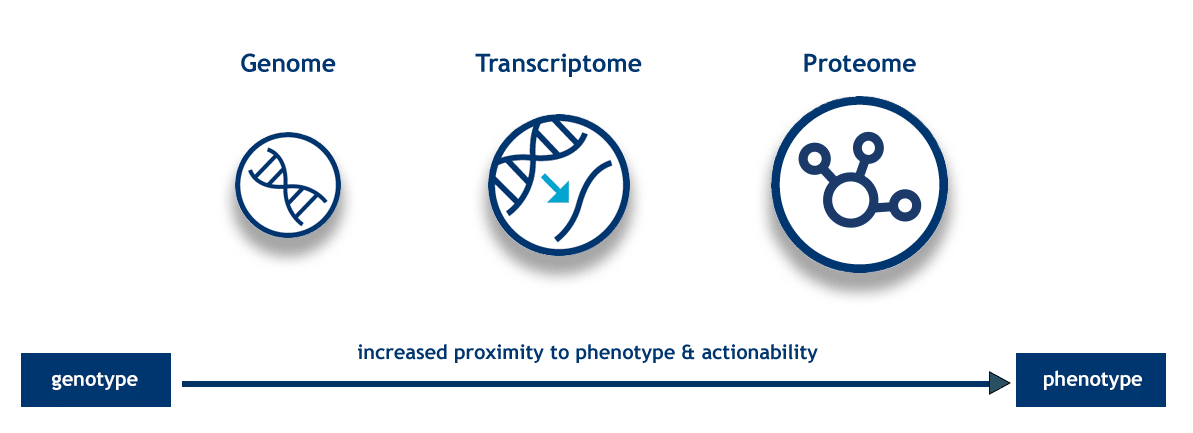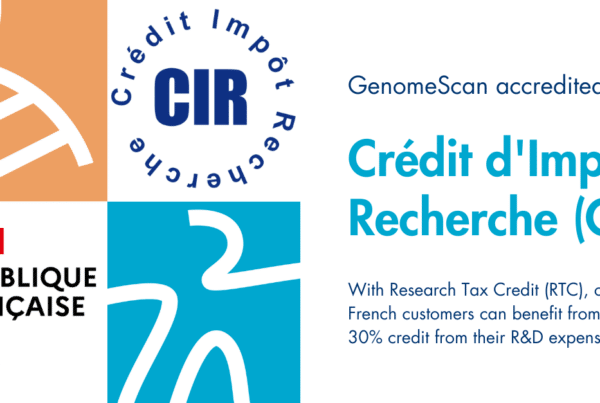GenomeScan expands its multiomics capabilities with Olink proteomics

Proteins are both dynamic indicators of disease states and the most actionable targets for therapeutics. For years, technologies to detect or quantify proteins have been limited in applicability due to low throughput, poor sensitivity and specificity, and large sample volume requirements. However, recent technological developments are elevating high-throughput proteomics to mainstream. GenomeScan is partnering with Olink Proteomics to make proteomics more accessible by enabling high-throughput analysis of thousands of proteins, while using less than a drop of blood.
Proteomics in GenomeScan’s multiomics portfolio
What makes multiomics so attractive is its ability to capture the complete picture of biological processes, as each “omics” layer provides unique information about the functioning of the system. By combining different omics approaches, GenomeScan facilitates researchers in identifying the regulators of biological processes, identifying new targets for drug discovery, evaluating therapeutic interventions, and identifying biomarkers that can be used for diagnosis, prognosis, and disease monitoring, leading to more precise and effective treatments.

Proteins are not only the executors of most biological processes (e.g. enzymes, cytokines, transcription factors), but they also are the targets of most current drugs. These make them dynamic indicators of phenotype in health and disease and the most actionable targets for therapeutic interventions. As a stand-alone assay, or in combination with GenomeScan’s complementary omics portfolio, proteomics analyses provide actionable insights into the biology of health and disease in a fast and effective way. Our multiomics portfolio now includes:
- Genomics
- Epigenomics
- Transcriptomics
- Proteomics
- Metagenomics
Innovative Proximity Extension Assay (PEA) technology
Olink’s PEA technology that is based on dual antibody recognition results in the coupling of DNA oligonucleotides and boasts exceptional levels of specificity, sensitivity, and dynamic range.
The PEA technology works in 3 steps:
- Antibody pairs that are labelled with DNA oligonucleotides bind target antigen in solution.
- Oligonucleotides that are brought into proximity hybridize and are extended by a DNA polymerase.
- The newly created piece of DNA barcode is ready to enable protein quantification.
The dual binding of antibodies and DNA coupling together provide an exceptional specificity. In case of non-specific binding of antibodies, the oligonucleotides cannot hybridize and no signal will be generated.
High-multiplex immunoassays using only ~1 µl sample
Olink® Target 96 panel can perform 92 validated assays on 88 samples and Target 48 (cytokine) panel allows for simultaneous analysis of 45 protein biomarkers on 40 samples. 15 carefully designed Olink Target 96 panels cover key disease areas and biological processes including:
- Neurology
- Cardiometabolic
- Cardiovascular
- Immuno-oncology
- Oncology
- Inflammation
- Organ damage
- Development
- Metabolism
- Cell regulation
Another great aspect of Olink panels is the fact that they are compatible with various sample types such as human Plasma and serum, cerebrospinal fluid (CSF), urine, tissue lysate, interstitial fluid/microdialysis, ocular fluids, saliva, synovial fluid, and fine needle biopsies, and using only ~1 µl sample. This makes it ideal, for example, to implement as outcome markers in clinical trials.
Proteomics and multiomics in your projects
Would you like to learn how you can use our proteomics services on their own or in combination with other omics approaches to improve your biomarker discovery, target validation or clinical trials? Please reach out to our technical support specialists by filling in below form.





